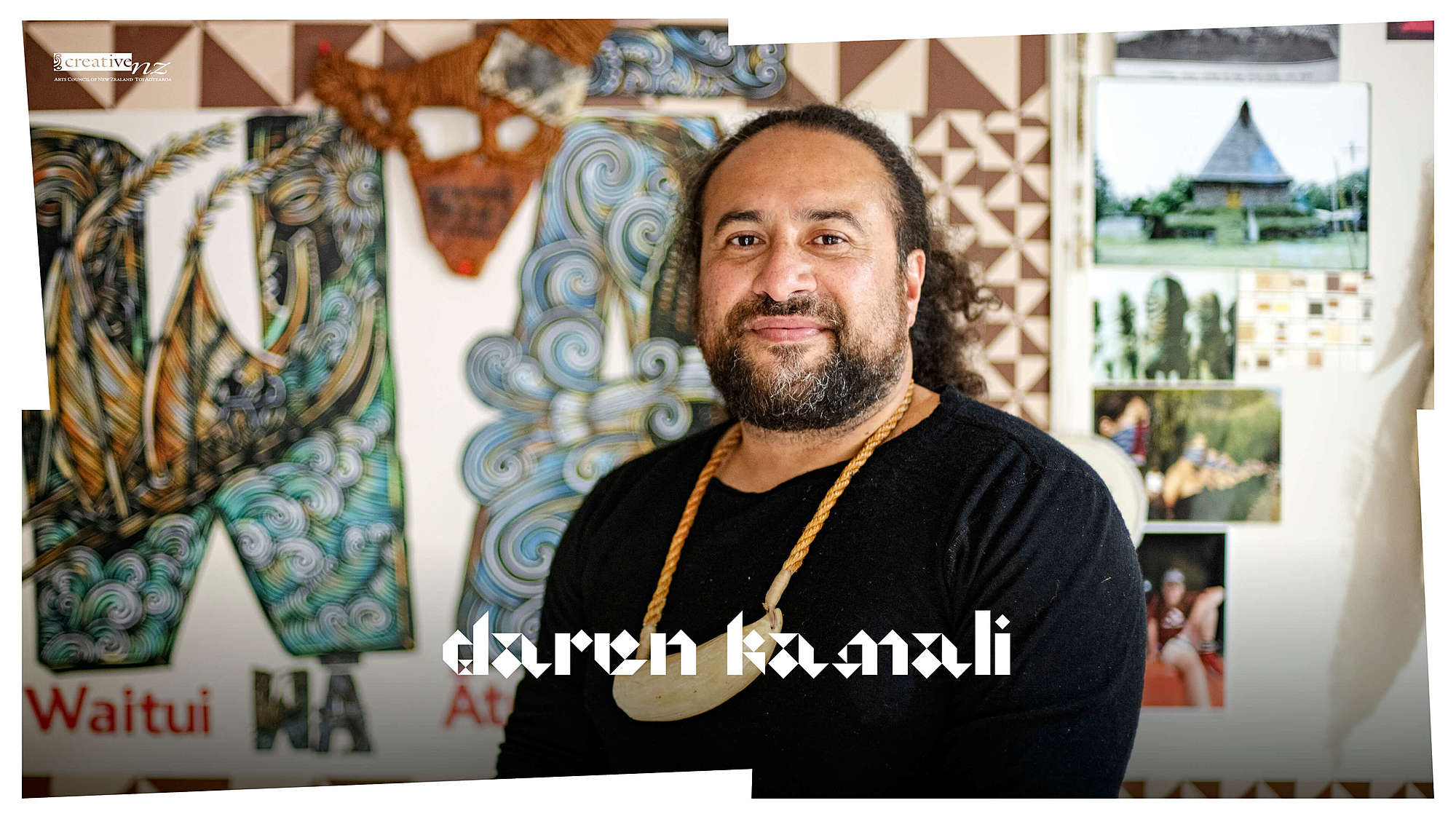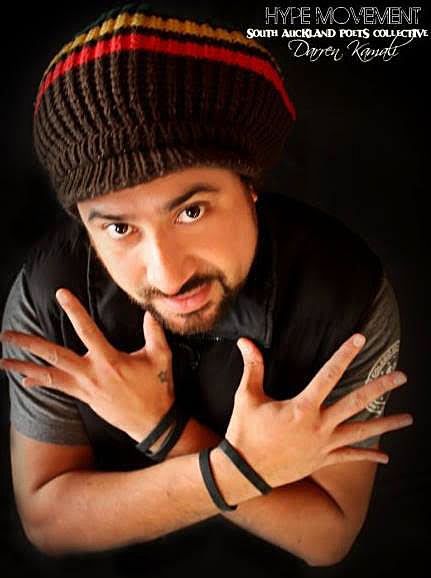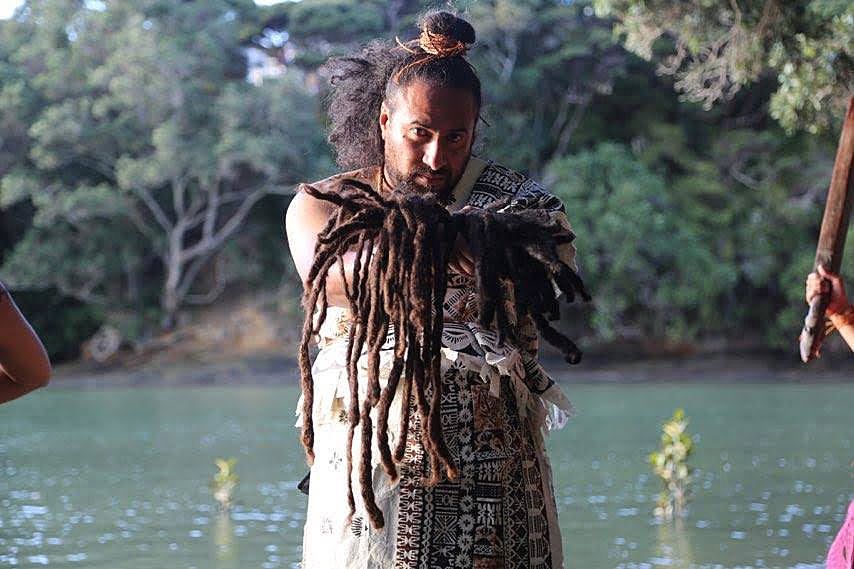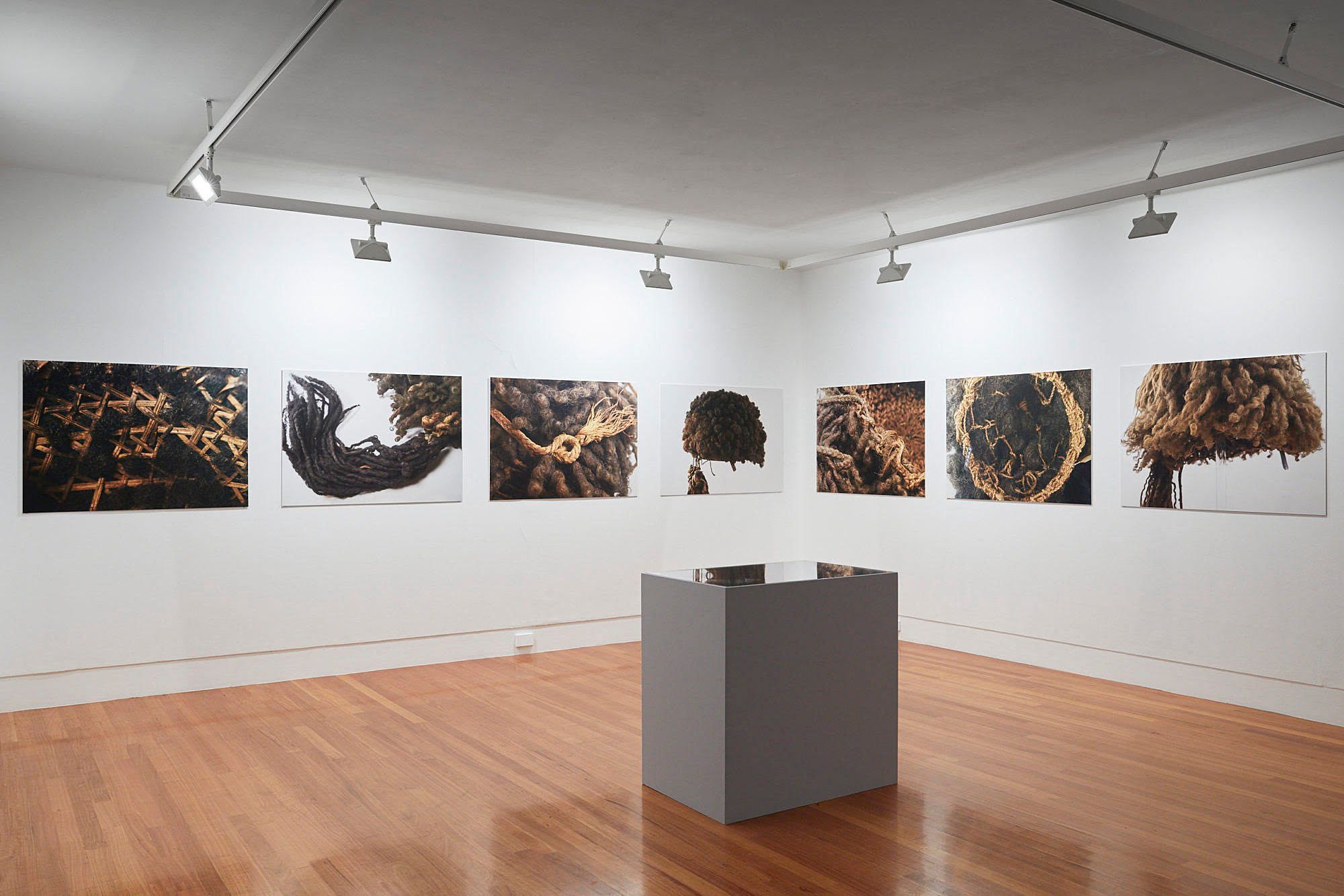From Barracks to Books: The Art of Preservation
Poet, performer and artist Daren Kamali on the inspirations in his work, bringing up a new generation of poets in the South Auckland Poets Collective, and how art can preserve our cultures.
We’re collaborating with Creative New Zealand to bring you the groundbreaking Pacific Arts Legacy Project. Curated by Lana Lopesi as project Editor-in-Chief, it’s a foundational history of Pacific arts in Aotearoa as told from the perspective of the artists who were there.
Wā: surname and connections to Pacific Island cultures through migration.
I was born and raised by my vasu (mother’s side) in Suva, Fiji, for the first 17 years of my life. The surname Kamali is my great-grandfather’s first name Kamali’eli (minus the eli): it was changed when my great-grandparents eloped to Fiji four generations ago, due to hierarchal differences; my great-grandmother, Katalina Falelavaki, was the chief’s daughter from Uvea (Wallis) and my great-grandfather, Kamali’eli Taisi, was a canoe builder from Futuna. They settled on the old Fijian capital of Levuka Island in the early 1900s.
I am of Fijian, Uvean and Futunan, Sāmoan and Scottish descent, but also have connections to Kiribati, Tahiti and Tonga.
Papa gifted me writing, family gifted me voice
And in Aotearoa – poetry and art found me.
My grandfather, Papa Ipolito, was a prolific writer, recording Fijian political matters and constantly writing me letters when I moved to Aotearoa. He was the only one with a typewriter in our village of barracks.
Ever since I can remember, I was interested in and excited about the arts. We as a family, especially as children, were expected to have an item ready to perform at family birthdays and gatherings. At church we had to wear our best attire and sing hymns in tune so God would be pleased. I sometimes reminisce about those times and laugh to myself, it groomed me to be a creative although I was super shy, something I have become great at hiding.
Aotearoa has been my home away from home since 1992. It is here that poetry and arts found me. In 1998, at the age of 23, I began busking street poetry on the streets of Auckland’s CBD. Since then I’ve established myself as a poet, performer, researcher, revival activator and multimedia artist, and my current role is Senior Curator Pacific for Auckland Libraries.
Inspirations and influences of my creation and
writings are drawn from the two worlds that nurtured me.
Image by Ralph Misa Photography, 2010.
These elements are a combination of the islands and city, the old and new worlds, traditional and contemporary settings and the ocean, people, language, culture and places in Aotearoa, the Pacific and other countries I’ve experienced.
While busking on the streets, I got picked up by music producer Lee Baker, who gave me my first break by releasing my debut musical album Bulaotearoa: Immigrant Story in 2000, followed by the EP Keep it Real in 2004. Everything in those recordings was written as poetry before being rearranged and composed into verses, choruses, bridges, melodies, raps, chants and spoken word.
Since then, music and poetry have taken me to the United States, Ukraine, United Kingdom, Holland, Dubai, Singapore, Australia, Tahiti, Sāmoa, Tonga, Rarotonga, Palau, the Solomons, Hawai’i, Fiji and also across Aotearoa.
A step back into poetry writing and
giving back to the community.
Masi and Hair - by Julia Mage’au Gray, 2015.
After my first seed was born in 2006, I decided to take time out from music and invest more time in publishing my poems. These earlier poems were mainly reminiscent of growing up in Fiji, reflecting on Fijian myths and legends like the veli (dwarf gods that lived in the forest), drawn from songs, chants, hymns, village, church and family, which I submitted to various Pacific anthologies, starting with Niu Voices, collated by Dr Selina Tusitala Marsh in 2006.
My mentor, Rev. Mua Strickson Pua, introduced me to poetry and art during my early years busking on the streets. His message to me was “remember that once you establish yourself through your talent(s), you must gift your time and work back to our youth community”; just as he had gifted his time and work to me, I felt the need to do the same. There was a gap for more support and mentorship for our Pacific and Māori youth, so I started giving back to our youth community here in Auckland.
I started branching into a career as a freelance creative youth worker, facilitating creative writing and music workshops. This led to me becoming Director of Music at Wesley Community Centre for Auckland Council for the year 2007. That year ended with a musical production of Our Street, directed by Justine Simei-Barton, which sold out six shows at the Auckland Town Hall.
At this time poetry was still fresh to our youth scene, with slam poetry slowly becoming popular. However, the term ‘spoken word’ was unheard of at this point. I guess rhymes, or poetry, were heavily associated with hip hop or rap by most youth back then. By 2007 word of my work as a creative youth facilitator, predominantly my work with Pacific and Māori youth, had reached Youthline and we started an initiative around poetry writing and performance with Pacific and Māori youth from around South Auckland.
At this time poetry was still fresh to our youth scene, with slam poetry slowly becoming popular
Initially, the programme entailed ten weeks of workshops, leading up to the group performing at Splore Festival2008. The South Auckland Poets Collective (SAPC)was born out of this performance. I became a co-founder alongside Ramon Narayan and Grace Taylor. At this point SAPC was a collective of ten poets, a combination of social workers and youth.
These youth were vibrant, intelligent, creative and keen to continue writing and performing. They enrolled on this creative programme as an alternative education option. The youth poetry movement was just starting in terms of performance and slams in Aotearoa, and SAPC was the place for both youth and young adults to go to audition, write, create and perform. With the support of Youthline, SAPC developed this initiative to consist of weekly meetings at Youthline Central and South Auckland, and I was poet facilitator for the next six years.
SAPC was the place for both youth and young adults to go to audition, write, create and perform
We toured Aotearoa. We self-published our collection of poetry, Somethingworthreading?, in 2010, accompanied by a 30-minute DVD. We attended the world poetry youth slam Brave New Voices in 2012 and set up our own New Zealand youth slam team in 2019. All these stepping stones and achievements were made possible for SAPC by Action Education (an arm of Youthline) and the amazing support of Creative New Zealand.
SAPC established themselves as leaders.
Spoken word and youth slam poetry movements established themselves here in Aotearoa, with young voices rising from South Auckland, across Aotearoa and across the Tasman. Spoken-word group Ngā Hine Pūkōrero, made up of Te Rina Wichman-Evans, Arihia Hall, Manaia Tuwhare-Hoani and Matariki Bennett, won WORD – The Frontline,an Aotearoa inter-school poetry slam competition, and then went on to win the trans-Tasman championship in Australia in 2019. Ngā Hine Pūkōrero then went on to be the first-ever South Pacific youth poetry representatives at Brave New Voices, in July 2019 in America, taking the runner-up title. This was a major achievement for Aotearoa poetry on the international stage. I would like to believe that SAPC changed the face of poetry performance and publishing in Aotearoa over the last decade.
To date, 36 poets have come through SAPC, and it has produced award winners, actors, dancers, writers, performers, artists, researchers, activators, teachers, professors, marine biologists, business owners, librarians, curators, musicians, theatre directors and activists.
Further studies after 15 years
more publishing, awards, residencies and funding.
By 2011, after 15 years, I was inspired to return to tertiary studies after meeting with Māori/Irish poet Robert Sullivan, who was Head of the Creative Writing School at Manukau Institute of Technology. I commenced a Diploma in Creative Writing, which led to a bachelor’s degree in creative arts. Within this time, I published my first collection of poetry, Tales, Poems and Songs from the Underwater World (Anahera Press, 2011). I was awarded the Fulbright Pacific Writer in Residence Award 2012 at the University of Hawai’i, Manoa, where I wrote my second collection, titled Squid Out of Water: The evolution (Ala Press, 2014). That year, I was the first Aotearoa-based Pacific Islander awarded a placement on the University of Iowa’s International Writing Program. A few years later, in 2017, I graduated from The University of Auckland with a first-class Master of Creative Writing.
Heritage revival, research, art.
(UN)Registered Savages of Aotearoa Hair to Stay, 2019 (installation view) eight photographs of ulu cavu in British collections photo by Sam Hartnett
In 2013, while working at the Auckland War Memorial Museum Tāmaki Paenga Hira, I started researching and developing the Ulumate Project – an iTaukei (Fijian) heritage art form of wig making, known as ulucavu. Ulucavu is an ancient practice that has been dormant for over 200 years. The Ulumate Project is very important to me and it started when I began growing my hair in 2007. The objective of this project is to photograph, document and revive the making of a contemporary ulucavu over several years, while also tracking down ulucavu collections from various museums around the world, with response through publications and exhibitions.
There are only two ulucavu in Aotearoa, one in Te Papa and one at the Auckland War Memorial Museum. Recent developments on the Ulumate Project saw us visit the Cambridge Museum of Archaeology and Anthropology in the UK in 2019, where they hold the largest ulucavu collection.
Forward thinking on art, work and life.
Arts for me have not always been a means to put food on the table, and over the years I’ve worked odd jobs like kitchen hand, labourer, customer service representative, nurse aide, landscaper, painter, glass cleaner, educator, facilitator and babysitter.
September 2020 will see my third poetry collection, titled Vunimaqo and Me: Mango Tree Collections, published by Kava Bowl Media in Aotearoa. This book is dedicated to my grandparents, so their legacy and memory will last forever. I wanted to acknowledge my gratitude for the experience of growing up in the village of barracks, especially to the people who had a hand in my upbringing in Fiji and Aotearoa.
Arts is a realm where I can go, to be myself, to think, to dream, to create, perform and write
Arts is a realm where I can go, to be myself, to think, to dream, to create, perform and write. Arts are also healing for me: they fill the gap of loneliness and lost, mixed or negative feelings, and capture special moments or memories. Most of all, arts for me are preserving my culture and language, expressing myself and telling stories.
cnz logo
This piece is published in collaboration with Creative New Zealand as part of the Pacific Arts Legacy Project, an initiative under Creative New Zealand’s Pacific Arts Strategy.
Series design by Shaun Naufahu, Alt group. Photo by Raymond Sagapolutele.





